Ladies and gentlemen, I thank Her Majesty’s Treasury and DFID
for organising this conference and inviting the Reserve Bank of India to share
India’s experiences in achieving greater financial inclusion (FI). We,
in India, have been greatly impressed by the focused attention being paid by the
UK Government to the subject of FI. I had read a very detailed report by the British
Banker’s Association in 2000 dwelling upon the issues involved in providing
greater access to financial services and the concept of a basic banking account.
The setting up the Financial Inclusion Task Force and the Financial Inclusion
Fund reflect the priority attached by the Government to the subject. DFID has
been involved in a number of livelihood diversification projects in India and
other countries especially for the marginalised and DFID’s stake in the
subject obviously derives from the development aspect of FI. The interest shown
by authorities in different countries in FI clearly show that there are concerns
that large segments of the world’s population are excluded from formal payments
system and financial markets while financial markets are developing and globalising
rapidly. There is an obvious market failure and thus governments and financial
sector regulators are seeking to create enabling conditions such that markets
become more open, more competitive, affordable and inclusive. Focus
of financial inclusion in India
The Indian economy is growing
at a steady rate of 8.5 % to 9% in the last five years or so. Most of the growth
is from industry and services sector. Agriculture is growing at a little over
2 %. The potential for growth in the primary and SME sector is enormous. Limited
access to affordable financial services such as savings, loan, remittance and
insurance services by the vast majority of the population in the rural areas and
unorganised sector is believed to be acting as a constraint to the growth impetus
in these sectors. Access to affordable financial services - especially credit
and insurance - enlarges livelihood opportunities and empowers the poor to take
charge of their lives. Such empowerment aids social and political stability. Apart
from these benefits, FI imparts formal identity, provides access to the payments
system and to savings safety net like deposit insurance. Hence FI is considered
to be critical for achieving inclusive growth; which itself is required for ensuring
overall sustainable overall growth in the country. The approach to FI in
developing countries such as India is thus somewhat different from the developed
countries. In the latter, the focus is on the relatively small share of population
not having access to banks or the formal payments system whereas in India, we
are looking at the majority who are excluded. FI can be thought of in two
ways. One is exclusion from the payments system –i.e. not having access
to a bank account. The second type of exclusion is from formal credit markets,
requiring the excluded to approach informal and exploitative markets. After nationalisation
of major banks in India in 1969, there was a significant expansion of branch network
to unbanked areas and stepping up of lending to agriculture, small industry and
business. More recently, the focus is on establishing the basic right of every
person to have access to affordable basic banking services. Measures
of financial exclusion 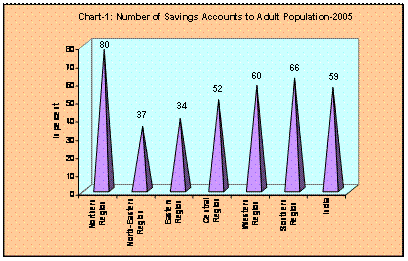
One
common measure of FI is the percentage of adult population having bank accounts
(Chart-1). Going by the available data on the number of savings bank accounts
and assuming that one person has only one account, (which assumption may not be
correct as many persons could have more than one bank account) we find that on
an all India basis 59 per cent of adult population in the country have bank accounts
– in other words 41 per cent of the population is unbanked. In rural
areas the coverage is 39 per cent against 60 per cent in urban areas. The unbanked
population is higher in the North Eastern and Eastern regions. 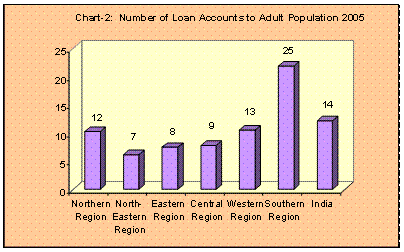
The extent of exclusion from credit markets is much more, as number of loan accounts
constituted only 14 per cent of adult population (Chart-2). In rural areas,
the coverage is 9.5 per cent against 14 per cent in urban areas. Regional differences
are significant with the credit coverage at 25 per cent for the Southern Region
and as low as 7, 8 and 9 per cent respectively in North Eastern, Eastern and Central
Regions.
The extent of exclusion from credit markets can be observed from
a different view point. Out of 203 million households in the country, 147 million
are in rural areas – 89 million are farmer households. 51.4 per cent of
farm households have no access to formal or informal sources of credit while 73
per cent have no access to formal sources of credit. Similar data
are not available for non farm and urban households.
Looking at the different sources of credit, it is observed that the share
of non institutional sources reduced from 70.8% in 1971 to 42.9% in 2002. However
after 1991, the share of non institutional sources has increased; specifically,
the share of moneylenders in the debt of rural households increased from 17.5
% in 1991 to 29.6% in 2002. In urban areas the share of non institutional sources
has come down significantly from 40% in 1981 to around 25 % in 2002. Who
are the excluded? The financially excluded sections largely
comprise marginal farmers, landless labourers, oral lessees, self employed and
unorganised sector enterprises, urban slum dwellers, migrants, ethnic minorities
and socially excluded groups, senior citizens and women. While there are pockets
of large excluded population in all parts of the country, the North East, Eastern
and Central regions contain most of the financially excluded population. Reasons
for financial exclusion
There are a variety of reasons
for financial exclusion. In remote, hilly and sparsely populated areas with poor
infrastructure, physical access itself acts as a deterrent. From the demand side,
lack of awareness, low incomes/assets, social exclusion, illiteracy act as barriers.
From the supply side, distance from branch, branch timings, cumbersome documentation
and procedures, unsuitable products, language, staff attitudes are common reasons
for exclusion. All these result in higher transaction cost apart from procedural
hassles. On the other hand, the ease of availability of informal credit sources
makes these popular even if costlier. The requirements of independent documentary
proof of identity and address can be a very important barrier in having a bank
account especially for migrants and slum dwellers. Recent initiatives
by Reserve Bank of India
The period 1969 to 1991 saw a
huge increase in the branch outreach in India as the average population covered
by a bank branch fell from 64,000 to 13,711. In 1991 along with reforms
for liberalising and opening the economy, financial sector reform aimed at deregulation,
increased competition and strengthening the banking sector through recapitalisation
and adoption of prudential measures. The Indian banking industry today is
quite robust and strong to be able to take on the challenges of achieving greater
financial inclusion. In the Annual Policy of the Reserve Bank for
2004-05, the Governor, Dr. Reddy observed and I quote -
“There has
been expansion, greater competition and diversification of ownership of banks
leading to both enhanced efficiency and systemic resilience in the banking sector.
However, there are legitimate concerns in regard to the banking practices that
tend to exclude rather than attract vast sections of population, in particular
pensioners, self-employed and those employed in unorganised sector. While commercial
considerations are no doubt important, the banks have been bestowed with several
privileges, especially of seeking public deposits on a highly leveraged basis,
and consequently they should be obliged to provide banking services to all segments
of the population, on equitable basis.” Pursuant to this, the
Reserve Bank has undertaken a number of measures with the objective of attracting
the financially excluded population into the structured financial system. In November
2005, banks were advised to make available a basic banking ‘no-frills’
account with low or nil minimum balances as well as charges to expand the outreach
of such accounts to vast sections of the population. Banks are required to make
available all printed material used by retail customers in the concerned regional
language. In order to ensure that persons belonging to low income group,
both in urban and rural areas do not encounter difficulties in opening bank accounts,
the know your customer (KYC) procedures for opening accounts has been simplified
for those persons with balances not exceeding Rs 50000/- (about GBP 600) and credits
in the accounts not exceeding Rs.100000/- (about GBP 1200) in a year. The simplified
procedure allows introduction by a customer on whom full KYC drill has been followed.
Banks have been asked to consider introduction of a General purpose Credit
Card (GCC) facility up to Rs. 25000/- at their rural and semi urban braches. The
credit facility is in the nature of revolving credit entitling the holder to withdraw
upto the limit sanctioned. Based on assessment of household cash flows, the limits
are sanctioned without insistence on security or purpose. Interest rate on the
facility is completely deregulated.
A simplified mechanism for one-time
settlement of overdue loans up to Rs.25,000/- has been suggested for adoption.
Banks have been specifically advised that borrowers with loans settled under the
one time settlement scheme will be eligible to re-access the formal financial
system for fresh credit. In January 2006, banks were permitted to utilise
the services of non-governmental organisations (NGOs/SHGs), micro-finance institutions
and other civil society organisations as intermediaries in providing financial
and banking services through the use of business facilitator and business correspondent
(BC) models. The BC model allows banks to do ‘cash in - cash out’
transactions at the location of the BC and allows branchless banking. Other
measures include setting up pilots for credit counselling and financial education.
A multilingual website in 13 Indian languages on all matters concerning banking
and the common person has been launched by the Reserve Bank on 18 June 2007. Strategies
and approach
At the regional level, a forum called the
State Level Bankers’ Committee (SLBC) has been in operation since nationalisation.
SLBC is a group of bankers and government officials and is convened by a bank
having major presence in the State called the SLBC convenor bank. It meets quarterly
and reviews the banking developments in the State. At the district level, the
district level committee functions; it is headed by the District Commissioner
and is convened by a designated lead bank for the district. In early 2006, one
district in each State was identified by the SLBC for 100 per cent financial inclusion.
So far, SLBCs have reported having achieved 100 per cent financial inclusion in
the Union Territory of Puducherry and in some districts in Haryana, Himachal Pradesh,
Karnataka, Kerala and Punjab. Reserve Bank proposes to undertake an evaluation
of the progress made in these districts by an independent external agency to draw
lessons for further action in this regard. In the districts taken up for
100% financial inclusion, surveys were conducted using various data base such
as electoral rolls, public distribution system, or other household data, to identify
households without bank account and responsibility given to the banks in the area
for ensuring that all those who wanted to have a bank account were provided with
one by allocating the villages to the different banks. Mass media was deployed
for creating awareness and publicity. The banks used different approaches to communicate
the advantages of having a bank account. Bank staff or their agents who
are usually local NGOs or village volunteers would contact the people at their
households. Ration card / Electoral ID cards of the families were taken for fulfilling
the simplified KYC norms. Photographs of all the persons who opened bank accounts
were taken on the spot by a photographer accompanying the bank team. In most States,
the product used for launching the program for financial inclusion is the ‘No
frills’ accounts. In one State the farmer’s credit card or KCC is
being used ensuring first to credit rather than savings. In other States no frills
account was followed by small overdraft facility or a general purpose revolving
credit upto pre-specified limit. Recognizing the need for providing social
security to vulnerable groups, in some cases in association with insurance companies,
banks have provided innovative insurance policies at affordable cost covering
life, disability and health cover. Cooperative banks and regional
rural banks being local level institutions are well suited for achieving financial
inclusion. These banks are being revived and strengthened with incentives for
better governance. Being local institutions they are ideally suited for achieving
FI. The role of an efficient payments system for FI cannot be overstressed
and we efforts are being made to bring about Improvements in the payments system
especially in the relatively less developed parts of the country.
Huge increase in no frills accounts 
The outcome of the efforts made is reflected in the increase of 6 million
new ‘no frills’ bank accounts opened between March 2006 and 2007.
In view of their vast branch network (45000 rural and semi urban branches) public
sector banks and the regional rural banks have been able to scale up their efforts
by merely leveraging on the existing capacity. FI is being viewed by these
banks as a huge business opportunity in an overall environment that facilitates
enterprise and growth. It provides them a competitive advantage and defines
a clear niche for their growth. Use of intermediaries
One of the ways in which access to formal banking services has been provided
very successfully since the early 90s is through the linkage of Self Help Groups
(SHGs) with banks. SHGs are groups of usually women who get together and
pool their savings and give loans to members. Usually there is a NGO that promotes
and nurture these groups. National Bank for Agriculture and Rural Development
has played a very significant role in supporting group formation, linking them
with banks as also promoting best practices. The SHG is given loan against guarantee
of group members. The recovery experience has been very good and there are currently
2.6 million SHGs linked to banks touching nearly 40 million households through
its members. Banks provide credit to such groups at reasonable rates of interest.
However the size of loans is quite small and used mostly for consumption smoothening
or very small businesses. In some SHGs, credit is provided for agricultural activities
and other livelihoods and could be several times the deposits made by the SHG.
Most of the SHGs have been linked to public sector banks in view of the latter’s
dominant presence in the rural areas.
The foreign banks and private
sector banks have approached the access issue through either setting up relatively
lower cost non bank companies for providing small value retail loans or have partnered
with micro finance institutions that provide financial services to the relatively
higher risk segments of the population. Microfinance has drawn attention to an
entire sector of borrowers who had been previously poorly served by the formal
financial sector - and MF has demonstrated how to make lending to this sector
a viable proposition. However the rates of interest charged are quite high, typically
24 to 30 per cent, mainly on account of the high transaction cost for the average
loan size that can be quite small. Compared to the informal sector, perhaps the
rates are lower, but issues are raised whether these rates are affordable - in
the sense whether they would leave any surplus in the hands of the borrowers and
lead to higher levels of living.
For commercial banks, the lower cost
of funding, advantages of size and scale gives scope for cross subsidization and
their interest rates are more competitive compared to the MFIs, but they have
not been as successful in dealing with the last mile issue. The partnering with
SHGs and MFIs with reasonable cost of funding by the banks has been seen as a
more optimal approach till now.
As indicated earlier, a recent important
regulatory measure is the permission given to banks to use post offices, cooperative
societies, non government organisations set up as trusts or societies, as business
correspondents (agents) for doing branchless banking after conducting due diligence
on such intermediaries. Agency risk is sought to be minimised by using well respected
local organisations and use of IT solutions for tracking transactions in the bank
accounts. Many banks are exploring the use of this model to increase their outreach
and deliver doorstep banking services at lower cost. The viability and scalability
of the model would require some flexibility in charging of interest rates or services
charges to cover costs.
IT solutions for financial inclusion
The use of IT solutions for providing banking facilities
at doorstep holds the potential for scalability of the FI initiatives. Pilot
projects have been initiated using smart cards for opening bank accounts with
bio metric identification. Link to mobile or hand held connectivity devices ensure
that the transactions are recorded in the bank’s books on real time basis.
Some State Governments are routing social security payments as also payments under
the National Rural Employment Guarantee Scheme through such smart cards (see pictures
below). The same delivery channel can be used to provide other financial services
like low cost remittances and insurance. The use of IT also enables banks
to handle the enormous increase in the volume of transactions for millions of
households for processing, credit scoring, credit record and follow up. Initiative
of a State Government - pictures of technology at work Pensioners
with Bio-metric cards line-up to receive payments
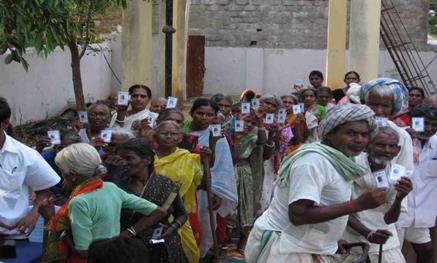 Biometric
validation of Smart Card
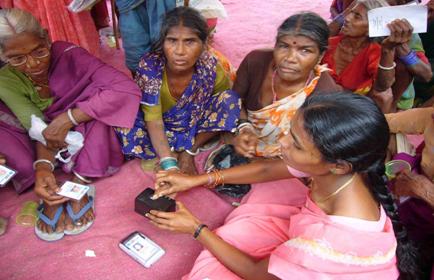
Transaction Confirmation Receipt
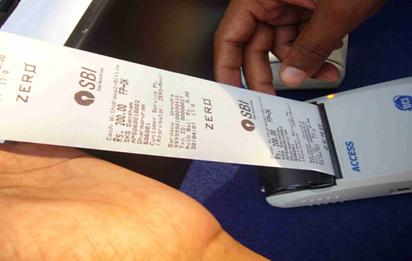
Role of Government
State Governments can play
a pro –active role in facilitating FI. Issuing official identity documents
for opening accounts , creating awareness and involving district and block level
functionaries in the entire process, meeting cost of cards and other devices for
pilots, undertaking financial literacy drives are some of the ways in which the
State and district administration have involved themselves.
India Post
is also looking to diversify its activities and leverage on its huge network of
post offices, the postman’s intimate knowledge of the local population and
the enormous trust reposed in him. Banks are entering into agreements with India
Post for using post offices as agents for branchless banking.
Work in progress The Finance
Minister in his budget for 2007-08 has announced the setting up of two funds for
FI; the first called Financial Inclusion Fund for developmental and promotional
interventions and the other called Financial Inclusion Technology Fund to meet
cost of technology adoption of about $ 125 million each. The scope of these funds
is being worked out. Setting up of financial literacy centres and credit counseling
on a pilot basis, launching a national financial literacy campaign, forging linkages
with informal sources with suitable safeguards through appropriate legislation,
evolving industry wide standards for IT solutions, facilitating low cost remittance
products are some of the initiatives currently under way for furthering FI. Thank
You.
Text of speech by Smt. Usha Thorat, Deputy Governor, Reserve Bank of
India at the HMT-DFID Financial Inclusion Conference 2007, Whitehall Place, London,
UK on June 19, 2007. |